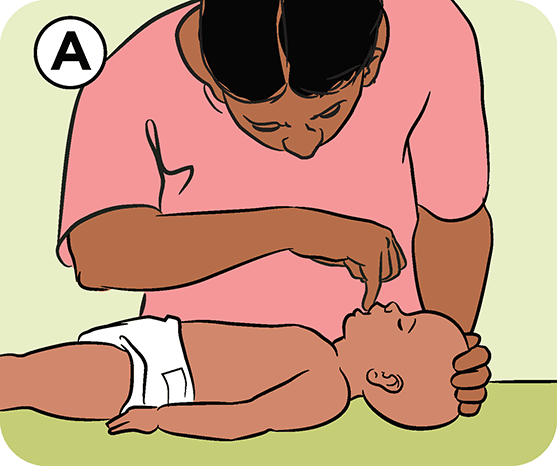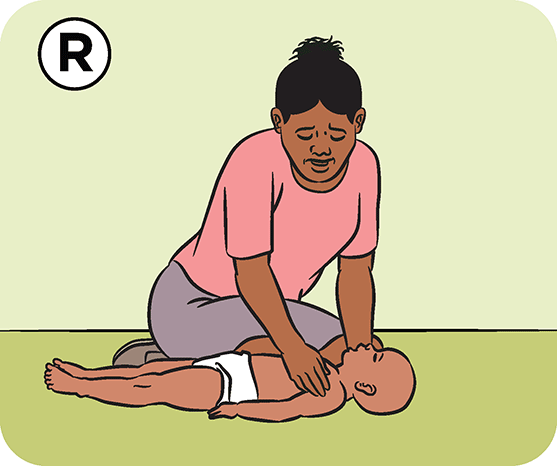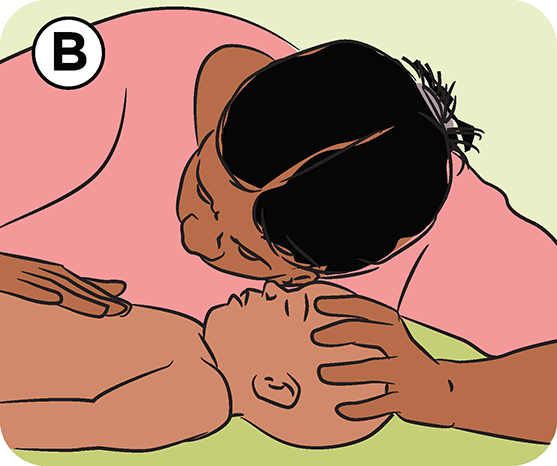Infant Isn't Breathing Normally but Has a Pulse
Give a rescue breath to a baby. Give 1 breath every 5 to 6 seconds.

Cpr For Newborns And Babies In Pictures Raising Children Network
Decades ago doctors worried that.

. If you cannot make a seal around the mouth and nose close the babys mouth and make a seal around the nose only. How do you deliver rescue breaths. Tilting the childs head back opens the airway by pulling the tongue forward.
A heart rate of less than 60 beats per minute is considered cardiac arrest in children and infants. Rescue breaths can be given alone when a person has a pulse but isnt breathing. Person begins breathing normally on their own.
At 6 months babies breathe about 25 to 40 times per. If they are not breathing their chest and stomach will not be moving and you will not hear or feel their breaths. This is also called rescue breathing Adults.
Push down 15 times. You should compress the chest about two inches. Signs of Breathing Problems.
Check for breathing by tilting their head back and looking listening and feeling for breaths. If they are not breathing their chest and stomach will not be moving and you will not hear or feel their breaths. Step 1 of 3.
At 1 minute after birth the infant has a heart rate of 80 beats per minute gives irregular gasps has blue hands and feet but a pink tongue has some muscle tone but does not respond when dried. The cause is unknown. After performing CPR for 2 more minutes there is still no pulse and you are still alone.
After 15 compressions give the victim two breaths. Place your hands in the middle of the victims chest directly between his nipples. Skin color change turning pale or blue irregular or stopped breathing unresponsiveness and a change in muscle tone.
If the victim is still not breathing begin chest compressions. Child is not breathing normally but has a pulse. If the person is a baby or child age 1 to puberty and he or she is not breathing but has a pulse give 1 rescue breath every 3 to 5 seconds or about 12 to 20 breaths per minute.
For Infants 1 month to 12 months old. If the person is a baby or child age 1 to puberty and he or she is not breathing and has no pulse do chest compressions and rescue breathing for 2 minutes 5 cycles of 30 compressions and 2 rescue. Check for breathing by tilting their head back and looking listening and feeling for breaths.
Medic 76 per the caller the infant was feeding and started to cough and turn blue she appears to be awake and breathing normally at this time. 1 breath every 2-3 seconds or about 20 to 30 breaths per minute. If your little one is a baby under age 1 alternate between giving him five back blows and five chest thrusts to dislodge the item causing the choking again while someone calls 911.
His airway is not obstructed. For Adults 12 years and older Pulse rate 60 to 100 beats per minute Respirations 12 to 20 breaths per minute. If there is a pulse and noabnormal breathing start rescue breathing 1 breath every 2-3 seconds.
Breaths per minute for a. If youve determined at this point that the infant is unresponsive not breathing normally but does have a pulse above 60 beats per minute continue immediately with rescue breathing. You check the childs pulse after 2 minutes of providing rescue breaths and cannot feel a pulse.
1 breath every 2-3 seconds 20-30 breathsmin after 2 minutes of rescue breaths there is no pulse. Do this for no more than ten seconds. If there is a pulse and breathing continue to monitor and support breathing.
Typically a newborn takes 30 to 60 breaths per minute. This can slow down to 20 times per minute while they sleep. Therefore its important to know what range is normal when it comes to pulse rates and respirations.
How should you deliver rescue breathes for a child who is not breathing normally but has a pulse. Normal newborn breathing. To be considered a BRUE the event must resolve within one minute on its own.
Normal breathing of course is just that gentle breathing that isnt difficult in the least and doesnt interrupt your tots activity. Take a breath in and place your lips around the babys mouth and nose to form an airtight seal. If there is no sign of breathing or pulse begin CPR starting with compressions.
Tilting the babys head back opens their airway by pulling the tongue forward. If there is no pulse and noabnormal breathing. BRUE episodes happen in babies younger than 1 and can include one or more of the following.
Notice that with infants we check for a pulse using the brachial artery rather than the carotid artery. You immediately begin CPR. Click to see full answer.
Fast and labored breathing may be caused by pneumonia. Rapid breathing over 60 breaths per minute for more than a minute or two requires medical attentionNote that its normal for babies to have period breathing. That is by fluid buildup in the very smallest airways due to infectionThis is a very serious condition.
If there is anything in their mouth pick it out and ensure the airway is clear and open. You immediately begin CPR. You can reduce to priority two per Engine 78 on scene.
Airway is not obstructed. Resuscitation is started and at 5 minutes the infant has a heart rate of 120 beats per minute and is breathing well. What is the next step.
If the patient definitely has a pulse but is not breathing adequately provide ventilations without compressions. Do this for no longer than 10 seconds. For Children 1 year to 12 years old Pulse rate 80 to 100 beats per minute Respirations 15 to 30 breaths per minute.

Cpr For Newborns And Babies In Pictures Raising Children Network

Cpr For Newborns And Babies In Pictures Raising Children Network

Cpr For Newborns And Babies In Pictures Raising Children Network

No comments for "Infant Isn't Breathing Normally but Has a Pulse"
Post a Comment